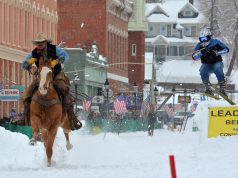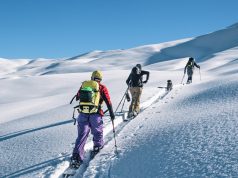
Ethan Green is a busy man. Boulder Weekly tracks him down on a cool November morning. He’s got a day full of meetings, a major fundraising bash has just wrapped up, there’s a storm coming to the high country — plus he wants to go skiing and check out Colorado’s high country, and avalanche season is in full swing. All in all, it’s just another day for the Boulder High graduate who currently heads the Colorado Avalanche Information Center (CAIC), the statewide snow and avalanche forecasting and educational service that is based in Boulder.
Back in 1988, when Green graduated from Boulder High, he didn’t know much about avalanches. He didn’t even really have a long-term plan for his life. An enthusiastic skier and climber, he gravitated to Telluride and the wild remote peaks of the San Juan Mountains rather than heading off to college like most of his peers. It was a decision that would change his life.
“I was very much into skiing and climbing and the mountains,” Green recalls. “I only had a little avalanche knowledge. My uncle was a climber, he had some experience with avalanches, and he taught me a few things.”
Green’s learning curve accelerated quickly after he headed south.
“I moved directly from Boulder to Telluride, and in Telluride I quickly figured out that I needed to learn a lot more about avalanches,” says Green. “I started spending time with mountaineers and other people who spent a lot of time in risky terrain, and I started to get very interested in the science of avalanches.”
Green’s curiosity led him to depart Telluride after two years for Montana State University, where he enrolled as an undergraduate. At first it was a disappointment.
“I wanted to learn more about avalanches, but there wasn’t much you could do as an undergrad,” says Green. But one moment changed everything.
“One of the courses I took was an introductory course on weather, and they brought in a grad student to talk about his work,” Green says of what would be a defining moment of his career.
That grad student happened to be another Boulder High graduate by the name of Karl Birkeland. At the time, Birkeland was on his way to becoming one of North America’s most respected avalanche and snow scientists. He was also launching the newly founded Gallatin National Forest Avalanche Center. Green smelled an opportunity and quickly buttonholed Birkeland after the lecture.
“I gave a lecture about the weather and climate and their relationship with avalanches, and this kid came up and said, ‘I want to do that,’” recalls Birkeland. “I had just started the center, so he became an intern. Ethan was super-motivated to learn.”
Meanwhile, to complement his internship at the newly founded avalanche center in Montana, Green scored a position with the ski patrol at Big Sky, a ski area that features some of the steepest and most avalanche-prone terrain in Montana.
Green’s hands-on experience at Big Sky complements his academic background, ivory tower qualifications that might seem surprising given his predilection for skiing, climbing and the outdoors. However, Green is an individual who has spent plenty of time hitting the books along with hitting the slopes. With a degree in meteorology from the University of Utah (obtained as a transfer student from Montana State), he also holds an M.A. in atmospheric science from Colorado State University as well as a Ph.D. from the same school.
“Understanding avalanches requires a lot of different sciences,” says Birkeland. “Geography, the earth sciences, how to relate to the landscape spatially, see different patterns, and yet you also need to understand physics and math behind how avalanches happen, what happens when snow crystals change, what happens when snow fractures.”
A lot of this doesn’t apply to the average backcountry enthusiast, says Birkeland. “The level that Ethan is operating on to create the kind of tools that he is trying to create for his forecasting crew at the CAIC is exceptional. His M.A. in atmospheric science, his Ph.D. and his practical background as a ski patroller is why he is so effective.”
Green also seems to have a knack for being in the right place at the right time, from the classroom where Birkeland was giving his presentation to being tagged as the next director of the Colorado Avalanche Information Center.
“Knox Williams, the former director of the CAIC, was retiring after more than 30 years on the job,” says Green. “And he asked me if I wanted to have the position. I thought, ‘Well, if he’s been there 30 years, that means that job openings like this don’t come around very often,’ so I decided that I better take it.”
It’s a position that seems to be a custom fit for Green. Colorado has a complex winter environment, with multiple mountain ranges and weather patterns, making it a paradise for snow science geeks like Green, who thrives on the complexity of the state’s terrain, weather and snowfall patterns. Then there’s the human factor. Colorado historically leads the country in avalanche deaths, and the Denver metro area is full of winter sports enthusiasts, from skiers to snowmobilers, all of whom enjoy some of the easiest access to steep, avalanche prone terrain in the nation, an environment where Green’s background as a ski patroller is invaluable.
“Colorado has a history of avalanche involvement that starts in the 1800s,” says Green. “If you look at avalanche history, there are spikes in deaths that correlate with the boom and bust of mining periods, where most of the incidents are industrial related. But in 1950, the modern period starts, and then most of the deaths are recreational.”
“Colorado leads the United States in the greatest number of people getting killed by avalanches on average and also the most getting killed in total,” adds Green. “Avalanches kill more people than any other natural hazard in Colorado, that’s an average of 5.5 people [per year] in the last 10 years, but in the last five years that average has climbed to seven people a year.”
These are sobering statistics, especially when you consider that, according to Green, most of these deaths could be avoided.
“Changes in equipment make it easier to get into the backcountry to go skiing or snowboarding,” says Green. “It’s easier to get into the terrain, these sports have become much more popular, and if you look at magazines, it’s all about going into the backcountry and into bigger terrain, where avalanches are more likely.”
Because of easier access, says Green, people are making decisions that could kill them. “If we are looking at avalanches,” says Green, “90 percent of the time, the victim or the party triggers the avalanche that kills them. These are not people walking in the woods, these are people going into natural avalanche terrain and tipping the scale. That’s troubling, and tells us the problem is us.”
The human factor means that the work that Green and his team at the CAIC do is a combination of science and education.
“We are doing more and more education,” say Green. “It’s how to avoid these accidents. Most of them have some sort of human factor, with lots of signs to show people that it was a dangerous period. We look at that as a challenge: How can we deliver the information better to avoid accidents?”
“We try to get three points across to people,” adds Green. “Get current info, get educated and carry the proper equipment.
“The most important thing you can do is check the avalanche forecast,” he says. “Go to the CAIC website, and just paying attention to if an area is tagged green or red can be enough to save your life. The next thing is to take an avalanche course. You can go online and find good tutorials, then if you are spending a lot of time in the backcountry, take a multi-day course. A level one avalanche course will give you strategies for making good decisions, and put what you are seeing into context and practice.
“Finally,” says Green, “carry proper equipment. That means everyone in your group should have a beacon, shovel and probe at minimum.”
Preparation means that you’ll be able to take advantage of the fantastic winter sports opportunities that are available in Colorado, the same opportunities that motivated Green to head to Telluride after he wrapped up his commencement ceremonies at BHS, and the same opportunities that brought him back to Colorado, a hometown kid made good, running one of the most important and underrated services in the state for outdoor recreation.
“There are an incredible amount of opportunities in Colorado,” says Green. “We are so lucky to live so close to amazing mountains. When it comes to avalanches, don’t be paralyzed by fear. With some education and thinking about what you are doing, you can travel safely in the mountains all of the time. It is just a matter of figuring out when is the right time. The risks are real, but so are the rewards; there are a lot of resources, guiding services. Education and lot of people can help you. The risk is manageable.”
For more information, visit https://avalanche.state.co.us, the Colorado Avalanche Information Center’s comprehensive website for avalanche forecasting and snow safety information. Their avalanche hotline provides a fast and easy way to keep informed.
The American Avalanche Association’s website, www.americanavalancheassociation.org, is geared toward professional education, and offers seminars, classes and educational workshops.
Their comprehensive website includes links to avalanche courses taught by providers nationwide for both pros and recreational backcountry users.
Respond: [email protected]














